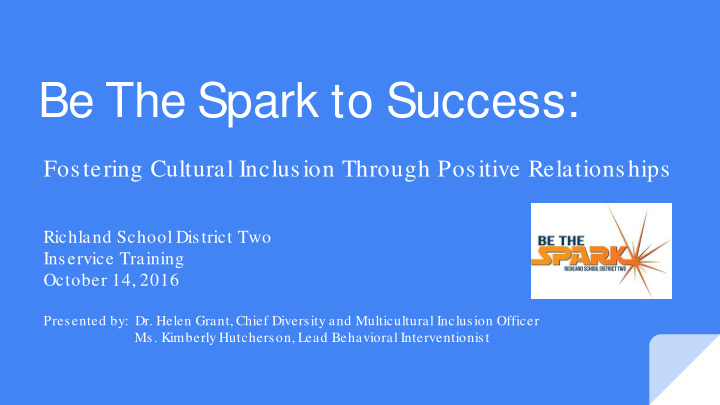



Be The Spark to Success: Fostering Cultural Inclusion Through Positive Relationships Richland School District Two Inservice Training October 14, 2016 Presented by: Dr. Helen Grant, Chief Diversity and Multicultural Inclusion Officer Ms. Kimberly Hutcherson, Lead Behavioral Interventionist
Welcome Richland Two is rich in cultural diversity and in this session, we will share specific techniques to foster cultural inclusion. We will look at how identifying and setting aside biases can positively impact relationships and enhance classroom and school environments.
g , language, disability, ethnicity, What is gender, age, religion, diversity? sexual orientation, Diversity is a collection of gender identity, attributes that include, but are socioeconomic status, not limited to, characteristics such as: veteran status, and differences among people concerning where they are from,
Some of our student demographics We have 27,842 students. We have the largest amount of growth in our Hispanic population that has increased by 58.80% African American 3.30% in the last 5 years. 23.70% Caucasian 46.87% of our students are on free or reduced lunch. 9.70% Hispanic 4.81% Other 2.86% Asian 0.16% American Indian or Alaskan Native
A few words about poverty The poverty threshold according to the Federal The educational impact of poverty on children is government is yearly income of $24,000 for a tremendous. They are more likely to: family of four. Fall behind Generational Poverty Be assigned to lower “tracks” Working Class Poverty Be retained in grade Immigrant Poverty Be labeled as “problem” students Situational Poverty Be absent, truant and to drop out Over time, earn lower scores in standardized
With that information in mind, Our goa oals a are to g o give you ou str trate tegies to to f foste ter posit itiv ive r rela latio ionship ips and nd c cul ultur urally respo pons nsive scho hool e env nvironm nment nts.
We’ll talk about Biases What they are? What to do about them? Classroom Strategies that help build cultural Inclusion It’s all about relationships. It helps to have good resources.
But first, let’s take a closer look at ourselves. Identity Swap Directions: You were given a confidential survey to complete when you entered today that we retrieved and have handed back out. When we read off the phrases, if it is checked off on the sheet you have (not if you checked it off on the sheet you filled out) please stand.
Bias The collection of learnings and Biases come from early learnings, experiences that shape our parents, family, schools, perceptions gives us a subjective neighborhoods, places of worship point of view - our own personal and from all the other places we gain understanding of ourselves and memories. others. This is bias. Bias is natural, normal and unavoidable. J ulie O’Mara
Explicit vs. Implicit Bias Explicit bias Implicit bias Expressed directly Expressed indirectly Operates consciously; you are aware of it Operates subconsciously; you are unaware of it Example: I will not teach him because he is black. Example: I really don’t think J amal has what it takes to be successful in this advanced placement class.
Why is this important? You are one of the educational Biases can cause us leaders in your school and you to make bad decisions impact the life of children every day. Reflect for a moment on how or to exercise poor important each decision is that you make each day. judgement.
Bias negatively impacts teaching.
For Example Listen to this clip reporting on a Bias Isn't Just A Police study conducted by the Yale Problem, It's A Preschool Child Study Center Problem nprED, September 28, 2016 npr segment
So, what should Self-reflection is the first step. you do? The first and most important thing for you to do is to acknowledge that you have biases and identify them. J ust knowing what they are will take you a long way toward avoiding their use.
If self reflection alone is not Select someone who knows you well and who has your best sufficient interests at heart. Explain to them the concept of bias and ask them to share with you what they notice to be your biases. Then, reflect on Ask a friend for help. that feedback, especially on how it may be impacting your work with your students (and colleagues).
Is She Ego Tripping?
Principles for Building A Learning Community ● Children are affirmed in their cultural connections ● Teachers are personally inviting ● Classrooms are physically inviting ● Students are reinforced for academic and behavioral development ● Changes made to accommodate culture are essential to learning ● Classroom is managed with clear behavioral expectations
Five Factors for Effective Teaching 1. Teacher knowledge of students cultural heritage, enthusiasm and responsibility for learners 2. Classroom activities encourage cultural relevancy 3. Differentiated assessments that allow for learning through choice 4. Effective feedback that addresses diverse learners and the learning process in the classroom 5. Effective interaction between the teacher and the students, creating an i t th t t d ti l t th l i
Culturally Relevant Practices Move Students from Compliance to Engagement: Know the Difference 1. Do I use Restorative Practices? 2. Are displays in my classroom representative of the students that I serve? 3. Do I survey my students to determine interest? 4. Do I modify my teaching and assessments to meet the needs of my students? 5. Do I provide an open space for dialogue and affirm the feelings, beliefs, and values of my students?
Cultural Implications & Learning: Panel Discussion Andrea Ballard, Parent Roberto Lopez, Teacher Dr. Shawn Suber, District-level Director Lee York, Director of Guidance
Questions?
References www.tolerance.org Dreamkeepers by Gloria Ladson Billings https://implicit.harvard.edu/implicit/takeatest.html
Recommend
More recommend